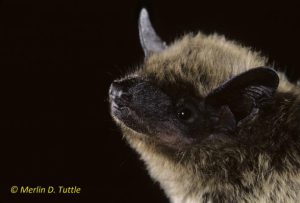The Case for Bats
Biological control is a pillar of integrated pest management. It may seem a bit daunting the principle is simple. All things in nature have predators including insects. Biological control is simply building a conducive environment for the predators of undesired pests. One animal not often thought of in this capacity is bats. Insectivores by nature, these underutilized creatures have a big impact to your open spaces. Their steady diet of moths (Lepidoptera), beetles (Coleoptera) and flies (Diptera, which includes mosquitoes) reduce insect pressure to your gardens and landscaping.
I know what you are thinking. How effective can they possibly be? Pregnant females consume up to two thirds of their body weight through the summer months while rearing pups. Bats are small but keep in mind that these are not solitary animals. In south Texas, a single large colony consumes enough insects to save cotton farmers an estimated $741,000 per year in insecticides. That is just to illustrate the point as you won’t be able to attract huge colony. There is no reason to believe a smaller colony will not provide similar services in your gardens.
Habitat
Now that your interest is piqued, how can you attract bats to your property? Installing a bat house is the easiest way. They are typically a two foot by one foot structure holding single or multiple chambers in which bats roost. It provides shelter from predation and weather while providing a place to rear pups. Though commercially available they may be built at home with minimal cost. Place the bat house in a location with morning sun at least 12 feet off the ground. Ensure there is enough airflow around the house to keep them cool, but that the structure is watertight. Mount houses on poles next to buildings and you’ll have better success attracting residents. With everything in place, it is time to discover who will most likely be your new neighbor.
The Bats of North Florida
Florida is home to 13 species of bats statewide. Of these, 11 may be found in the Panhandle but only 3 are common enough to be routinely seen. The Brazilian free-tailed bat (Tadarida brasiliensis) is the most common. Medium sized with brown fur, they have a long tail, wrinkled cheeks, and roost in man-made structures.
Second most common are Evening bats (Nycticeius humeralis). These dark brown to yellow bats have short ears with a broad hairless muzzle. They are tolerant of other bat species often roosting in tandem with them.
Finally, the panhandle is home to Southeastern Myotis (Myotis austroriparius). Easily the smallest of these bats, they are dull gray to brown with a lighter belly and long hairs between their toes. This species is the bat most likely to eat mosquitoes.
Finally, the panhandle is home to Southeastern Myotis (Myotis austroriparius). Easily the smallest of these bats, they are dull gray to brown with a lighter belly and long hairs between their toes. This species is the bat most likely to eat mosquitoes.
A Word of Caution
No article on wildlife would be complete without a word of caution. Bats are wild animals and should be treated as such. Never touch a bat on the ground as it most likely is not healthy. Bats do not generally cause issues but have been known to be disease vectors. Call a professional to collect the animal and never bring it into your home.
Bats can be a wonderful tool in controlling pests on your property. Creating habitat can help reduce pesticide need and cost to the homeowner. For more information on bats, see this Ask IFAS document, or contact your local extension agent for additional information on this and any topic regarding your gardens and more.
- Managing Storm Water in Landscapes - July 6, 2025
- It’s Time for Sweet Potatoes - May 22, 2025
- Ecological Benefit and Upkeep of Florida Lawns - April 21, 2025




